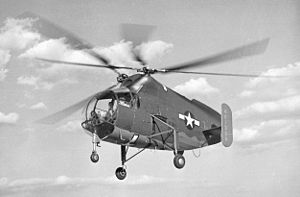avia.wikisort.org - Helicopter
The Kellett XR-8 (later redesignated XH-8) was a helicopter built in the United States during World War II. It was a two-seat machine intended to demonstrate the feasibility of a twin-rotor system and, while it accomplished this, it also demonstrated a number of problems that prevented further development of this particular design.
| XR-8 | |
|---|---|
 | |
| Role | Experimental helicopter |
| National origin | United States |
| Manufacturer | Kellett Autogiro Corporation |
| First flight | 7 August 1944 |
| Number built | 2 |
| Variants | Kellett XR-10 |
Design and development
The successful demonstration of the Sikorsky VS-300 had the USAAF favoring the helicopter over the autogiro as an approach to rotary-winged flight. Realizing this, the Kellett Autogiro Corporation made a proposal to the USAAF on 11 November 1942 for the development of a twin-rotor helicopter that would eliminate the need for a tail rotor and its attendant loss of power. Initially discounted on theoretical grounds, the proposal was re-examined in the light of tests done with models by the Army's Experimental Engineering Section, and was accepted on 7 January the following year. This was followed on 11 September with a contract for nearly $1,000,000 to build two prototypes with the three-bladed rotors contained in Kellett's proposal, along with an alternative two-bladed system.
The resulting aircraft had a stubby, egg-shaped fuselage with a single tail-fin and tricycle undercarriage. Two seats were enclosed side-by-side behind an extensively-glazed nose and the two rotors intermeshed with one another, offset by 12½°. The fuselage construction was of steel-tube, skinned in sheet metal and fabric, and the rotor blades were built of plywood ribs and skin attached to steel tubes. The intermeshing rotors quickly earned it the nickname "eggbeater".
Operational history
The first flight took place on 7 August 1944 with Kellett chief test pilot Dave Driscoll at the controls. A lack of directional stability was discovered, and was corrected by the addition of two extra tail fins. A far more serious problem was discovered on 7 September, when it was found that a blade from each rotor had collided while the aircraft was in flight. The Air Force therefore ordered Kellett to design a new, rigid rotor system for the XR-8.
In the meantime, the two-bladed rotor system was trialled on the second prototype, beginning in March 1945. This proved immediately unworkable, with severe vibration that was prohibitively difficult to resolve. Similarly, it became apparent that the rigid rotor system was going to require extensive redesign of the aircraft, and this effort was dropped as well.
On 23 January 1946, the XR-8 was accepted for service trials with its original, non-rigid rotors in place. However, the program was canceled almost immediately, and the prototype was eventually handed over to the National Air and Space Museum where it remains in 2008.
Variants
- XR-8 – initial version (1 built)
- XR-8A – version with two-blade rotor system (1 built)
- XR-8B – version with rigid rotor system (not built)
Specifications (XR-8)
Data from Jane's all the World's Aircraft 1947[1]
General characteristics
- Crew: 1
- Capacity: 1 pax
- Length: 22 ft 7 in (6.88 m) fuselage
- Height: 11 ft 0 in (3.35 m)
- Empty weight: 2,320 lb (1,052 kg)
- Gross weight: 2,975 lb (1,349 kg)
- Fuel capacity: 34 US gal (28 imp gal; 130 l) normal; 81 US gal (67 imp gal; 310 l) maximum
- Powerplant: 1 × Franklin O-405-9 6-cyl. horizontally-opposed air-cooled piston engine, 245 hp (183 kW)
- Main rotor diameter: 2 × 36 ft 0 in (10.97 m)
- Main rotor area: 1,017.5 sq ft (94.53 m2) each rotor
Performance
- Maximum speed: 100 mph (160 km/h, 87 kn)
- Service ceiling: 10,000 ft (3,000 m) *Hover ceiling: 3,000 ft (910 m)
- Disk loading: 35.2 lb/sq ft (172 kg/m2)
- Power/mass: 12.14 lb/hp (7.375 kg/kW)
See also
Aircraft of comparable role, configuration, and era
References
- Bridgman, Leonard, ed. (1947). Jane's all the World's Aircraft 1947. London: Sampson Low, Marston & Co. p. 244c.
Bibliography
- Allen, Francis (May–June 2004). "Ambitious 'Eggbeater': Kellet's XR-8 — Far Ahead of its Time". Air Enthusiast. No. 111. pp. 26–30. ISSN 0143-5450.
- Lambermont, Paul Marcel (1958). Helicopters and Autogyros of the World.
- Simpson, R. W. (1998). Airlife's Helicopters and Rotorcraft. Ramsbury: Airlife Publishing. p. 225.
- Taylor, Michael J. H. (1989). Jane's Encyclopedia of Aviation. London: Studio Editions. p. 558.
External links
На других языках
[de] Kellett XR-8
Die Kellett XR-8 Synchropter ist ein Hubschrauber des US-amerikanischen Herstellers Kellett Aircraft Corporation aus den 1940er-Jahren, von dem lediglich zwei Maschinen gebaut wurden. Eine gelegentlich behauptete Umbenennung in XH-8 nach dem ab 1948 gültigen System erfolgte anscheinend nicht mehr,[1] da zu dieser Zeit keines der beiden Exemplare mehr im Einsatz war.- [en] Kellett XR-8
[fr] Kellett R-8
Le Kellett R-8 ou Kellett XR-8 est un hélicoptère expérimental américain développé durant la Seconde Guerre mondiale[1] par l'ingénieur aéronautique Wallace Kellett pour étudier de manière concrète les rotors engrenants.Другой контент может иметь иную лицензию. Перед использованием материалов сайта WikiSort.org внимательно изучите правила лицензирования конкретных элементов наполнения сайта.
WikiSort.org - проект по пересортировке и дополнению контента Википедии